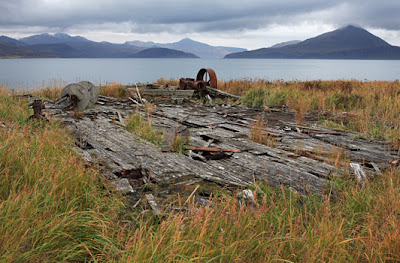Vulpes vulpes

The red fox is native to a few islands within the Aleutians, mainly in the eastern part. In 1759, Russians found them on Unmak Island (not Unimak) and began introducing them to other islands, keeping red, silver, and cross phases seperate. The Russians enjoyed a successful fox fur trapping industry, to go along with their otter fur harvests. After the Americans took control of Alaska in 1867, the farming and trapping of fox declined, due mainly to a lack of interest, that is until they decimated the sea otter populations (1880's) and otters became practically impossible to find. So what to do? Start hunting fox again (and add fox farming). For several reasons, the hunting, trapping and farming of fox died out in the 1930's. Then came the interruption of WWII, the Japanese invasion, and the forced evacuation then re-settlement of the Aleut people. The industry did not pick up. Many of the relocated fox died leaving some islands naturally devoid of them. Others hung by on eating ground mammals and birds. Several bird species have subsequently gained protected status and USFWS has taken lethal steps to protect these birds from the fox. Comments anyone? The fox population on Unimak Island, across from us, was hit hard in 1992 after a rabies epidemic contracted initially by land (river) otters. We aren't sure if foxes on this side of the pass were affected, but since land otter's carried the virus, and they like to swim, it seems likely.
"The red fox has several natural enemies: man (principally as trappers), wolves, coyotes, lynx, wolverines, and perhaps bears. Eagles are the major predators of young foxes in some areas. Sometimes foxes dig their own dens. More often, though, they appropriate and enlarge the homesites of small burrowing animals, such as marmots. They also will use abandoned wolf dens. Conversely, wolves may enlarge and use a fox's den.Foxes cache excess food when the hunting is good. They return to these storage sites and have been observed digging up a cache, inspecting it, and reburying it in the same spot. Apparently, they want to be sure that their food is still there." - AK Department of Fish and Game
This fox, and we've only seen one, lives somewhere nearby. We've seen him (a dog) or her (a vixen) a few times, up in the tundra, down on the beach, streaking past the windows at dusk. This feller could have rabies. It usually caries itself with its jaw dropped at a 90 degree angle, very strange looking. It could be a sign of heavy panting.


































